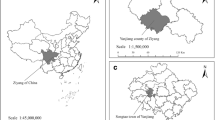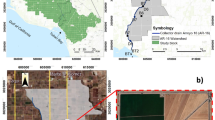Abstract
There are concerns about the impact of maize cultivation with high applications of nitrogen (N) and phosphorus (P) on water quality in surface waters in Mediterranean Central Chile. This study estimated the contribution of N and P from maize fields to nearby drainage channels and evaluated the effects in water quality. An N and P budget was drawn up for three fields managed with a maize-fallow system, El Maitén (20.7 ha), El Naranjal (14.9 ha) and El Caleuche (4.2 ha), and water quality variables (pH, EC, dissolved oxygen, total solids, turbidity, NO3-N, NH4-N, PO4 3−, COD, total N, total P and sulphate) were monitored in nearby drainage channels. The N and P balances for the three fields indicated a high risk of N and P non-point source pollution, with fertiliser management, soil texture and climate factors determining the temporal variations in water quality parameters. Elevated levels of NH4-N and PO4 3− in the drainage channels were usually observed during the winter period, while NO3 − concentrations did not show a clear tendency. The results suggest that excessive slurry application during winter represents a very high risk of N and P runoff to drainage channels. Overall, great emphasis must be placed on good agronomic management of fields neighbouring drainage channels, including accurately calculating N and P fertiliser rates and establishing mitigation measures.








Similar content being viewed by others
References
Arbat, G., et al. (2013). Soil water and nitrate distribution under drip irrigated corn receiving pig slurry. Agricultural Water Management, 120, 11–32.
Austin, A. T., et al. (2004). Water pulses and biogeochemical cycles in arid and semiarid ecosystems. Oecologia, 141, 221–235.
Armstrong, A., et al. (2011). Controls over nutrient dynamics in overland flows on slopes representative of agricultural land in North West Europe. Geoderma, 164, 2–10.
Ayers, R.S. & Westcot, D.A. (1994). Water quality for agriculture. FAO irrigation and drainage papers 29 Rev. 1. FAO, Rome. Resource document. FAO. http://www.fao.org/DOCREP/003/T0234E/T0234E00.HTM Accessed 11 August 2012.
Bermúdez-Couso, A., et al. (2013). Pollution of surface waters by metalaxyl and nitrate from non-point sources. Science of the Total Environment, 461, 282–289.
Bowes, M. J., et al. (2011). Changes in water quality of the river Frome (UK) from 1965 to 2009: is phosphorus mitigation finally working? Science of the Total Environment, 409, 3418–3430.
Buczko, U., et al. (2011). Assessment of the predictive quality of simple indicator approaches for nitrate leaching from agricultural fields. Journal of Environmental Management, 91, 1305–1315.
Casalí, J. (2008). Runoff, erosion, and water quality of agricultural watersheds in central Navarre. Agricultural Water Management, 95, 1111–1128.
Casanova, M., et al. (2013). The soils of Chile, world soils book series (185 p). Dordrecht: Springer Science + Business Media.
Cassidy, R., & Jordan, P. (2011). Limitations of instantaneous water quality sampling in surface-water catchments: comparison with near-continuous phosphorus time-series data. Journal of Hydrology, 405, 182–193.
Cherry, K. A., et al. (2008). Assessing the effectiveness of actions to mitigate nutrient loss from agriculture: a review of methods. Science of the Total Environment, 406, 1–23.
CIREN (1996). Estudio Agrológico. Descripción de suelos materiales y símbolos: VI Región (pp. 114–474)(in Spanish). Publicación N°: Centro de Información de Recursos Naturales.
D. N°95 (2008). Modifica reglamento del sistema de evaluación de impacto ambiental. Gobierno de Chile, Ministerio Secretaría General de la Presidencia (29.11.2008). Resource document. Ley Chile. http://www.leychile.cl/Navegar?idNorma=205385&idParte=&idVersion=2013-08-13 Accessed 03 September 2013.
Darwish, T., et al. (2011). Observation on soil and groundwater contamination with nitrate: a case study from Lebanon-East Mediterranean. Agricultural Water Management, 99, 74–84.
DEFRA (2010). Fertilizer manual (RB209) (8th ed., p. 257). UK: Department for Environment, Food and Rural Affairs.
DGA (2004). Diagnósticoy clasificación de cursos y cuerpos de agua según objetivos de calidad: Cuenca del Río Rapel, Gobierno de Chile, Ministerio de Obras Públicas, Dirección general de aguas. SINIA. (in Spanish): Resource document.
Di, H., & Cameron, K. (2002). Nitrate leaching in temperate agroecosystems: sources, factors, and mitigating strategies. Nutrient Cycling in Agroecosystems, 46, 237–256 http://www.sinia.cl/1292/w3-article-31018.html Accessed 11 August 2012.
Directive 2000/60/EC of the European Parliament and of the council of 23 October 2000 establishing a framework for community action in the field of water policy. Official Journal of the European Union. Communities L327/1. 72 pp.
Donoso, G., et al. (1999). Effects of agricultural activities in water pollution with nitrates and pesticides in the central valley of Chile. Water Science and Technology, 39, 49–60.
D.S. N° 90 (2001). Norma de emisión para la regulación de contaminantes asociados a las descargas de residuos líquidos a aguas marinas y continentales superficiales. Gobierno de Chile, Ministerio Secretaría General de la Presidencia (DO 07.03.2001). Ley Chile: Resource document (in Spanish). http://bcn.cl/4r47 Accessed 11 August 2012..
EEA (2005). Source apportionment of nitrogen and phosphorus inputs into the aquatic environment. EEA Report No. 7/2005 (European Environmental Agency ed., p. 48). Copenhagen.
EPA (1993a). Guidance manual for developing best management practices (BMP). United States Environmental Protection Agency (p. 163). Washington, DC.: Office of Water, EPA.
EPA (1993b). Determination of turbidity by nephelometry. EPA method 180.1. Environmental Monitoring Systems Laboratory. Office of Research and Development. U.S. Environmental Protection Agency (p. 10). Ohio: Cincinnati.
EPA (2004). Guidelines for water reuse. United States Environmental Protection Agency (p. 478). Washington, DC: Wastewater management, Office of Water, EPA.
EPA (2012). 2012 Edition of the drinking water standards and health advisories. Washington, DC: United States Environmental Protection Agency 822-S-12-001 Resource document. EPA. http://water.epa.gov/drink/standards/hascience.cfm Accessed 11 August 2012.
FAO (2010). The wealth of waste: the economics of wastewater use in agriculture, Food and Agriculture Organization of the United Nations (p. 129). Rome: Water Report No 35.
FAO (2012). Current world fertilizers trends and outlook to 2016 (p. 43) Resource document. ftp://ftp.fao.org/ag/agp/docs/cwfto16.pdf Accessed 20 October 2014. Rome: Food and Agriculture Organization of the United Nations.
Fuentes, I., et al. (2014). Morpho-physical pedotransfer functions for groundwater pollution by nitrate leaching in Central Chile. Chilean Journal of Agricultural Research, 74, 340–348.
Fuentes, I., et al. (2015). Preferential flow paths in two alluvial soils with long-term pig slurry additions in the Mediterranean zone in Chile. Soil Research, 53, 433–447.
Golembeski, R. C. (2004). Agricultural practices and nitrate pollution in ground water in the central valley of Chile (79 pp). Thesis of Master of Science: University of North Carolina at Wilmington.
Hach (2005). DR5000 spectrophotometer procedures manual (2nd ed., 846 pp). Germany: Hach Company.
Hanrahan, G., et al. (2003). Evaluation of phosphorus concentrations in relation to annual and seasonal physico-chemical water quality parameters in a UK chalk stream. Water Research, 37, 3579–3589.
Hatfield, J.L., et al. (1998). Swine manure management. In: Wright, R.J., Kemper, W.D., Millner, P.D. (Eds.). Agricultural uses of municipal, animal and industrial by products. USDA-ARS Conservation. Research Report N° 44, pp. 78–90, 1998.
Hofmann, B. S., et al. (2004). Tile spacing impacts on Zea mays L. yield and drainage water nitrate load. Ecological Engineering, 23, 251–267.
Iriarte, A. (2007). Evaluación especial de la lixiviación potencial de nitratos en suelos de la subcuenca del río Cachapoal bajo (p. 124)(in Spanish). Universidad de Chile: Memoria para optar al título de Geógrafo.
Kang, J., et al. (2011). Phosphorus leaching in a sandy soil as affected by organic and inorganic fertilizer sources. Geoderma, 161, 194–201.
Mallarino, A. P., et al. (2011). Nutrient uptake by corn and soybean, removal, and recycling with crop residue. pp. 103–113. In Proc. 23rd Annual Integrated Crop Management Conf., Ames, IA 30 Nov.–1 Dec. 2011. Iowa State University, Ames, IA. Iowa State University: Resource document http://www.agronext.iastate.edu/soilfertility/info/mallarino-2.pdf. Accessed 30 November 2012..
Najera, F., et al. (2015). Evaluation of soil fertility and fertilisation practices for irrigated maize (Zea mays L.) under Mediterranean conditions in central Chile. Journal of Soil Science and Plant Nutrition, 15, 37–48.
NCh 1333 (1987). Requisitos de calidad del agua para diferentes usos (p. 9)(in Spanish). Santiago, Chile: Instituto Nacional de Normalización.
Nelson, N. O., et al. (2005). Field-scale evaluation of phosphorus leaching in acid sandy soils receiving swine waste. Journal of Environmental Quality, 24, 2024–2035.
Neumann, A., et al. (2012). Nitrogen and phosphorus leaching losses from potatoes with different harvest times and following crops. Field Crops Research, 133, 130–138.
Nonato, E. A., et al. (2007). Statistical treatment of water quality parameters measured at the Upper Course of the Rio das Valhas basin. Quimica Nova, 30, 797–804.
ODEPA-CHILE (2007). VII Censo agropecuario: Ganadería y aves. Oficina de estudios y políticas agrarias, Gobierno de Chile. Resource document. ODEPA. (in Spanish). http://icet.odepa.cl/Accessed 22 August 2012.
Panagopoulos, Y., et al. (2011). Reducing surface water pollution through the assessment of the cost-effectiveness of BMPs at different spatial scales. Journal of Environmental Management, 92, 2823–2835.
Pizarro, J., et al. (2010). Nutrients dynamics in the main river basins of the centre southern region of Chile. Journal of Hazardous Materials, 175, 608–613.
Pizzeghello, D., et al. (2011). Phosphorus forms and P-sorption properties in three alkaline soils after long-term mineral and manure applications in north-estern Italy. Agriculture Ecosystems & Environment, 141, 58–66.
R Core Team (2014). R: a language and environment for statistical computing. Vienna: R Foundation for Statistical Computing URL http://www.R-project.org/..
Ribbe, L., et al. (2008). Nitrate pollution of surface water induced by agricultural non-point pollution in the Pocochay watershed. Desalination, 226, 12–20.
Rodríguez, J. (1993). La fertilización de los cultivos, un método racional (p. 291)(in Spanish). Colección en Agricultura: Pontificia Universidad Católica de Chile, Santiago.
Sadzawka, A. (2006). Métodos de análisis de aguas para riego. In Instituto de Investigaciones Agropecuarias, Serie Actas INIA N°37 (p. 332)(in Spanish). Santiago.
Salazar, O., et al. (2009). Evaluation of the DRAINMOD-N II model for prediction nitrogen losses in a loamy sand under cultivation in south-east Sweden. Agricultural Water Management, 96, 267–281.
Salazar, O., et al. (2011). Identification of hydrological factors controlling phosphorus concentration in drainage water in sandy soils. Journal of Soil Science and Plant Nutrition, 11, 31–46.
Salazar, O., et al. (2014). Monitoring of nitrate leaching during flush flooding events in a coarse-textured floodplain soil. Agricultural Water Management, 146, 218–227.
Salazar, O., et al. (2015). Inorganic nitrogen losses from irrigated maize fields with narrow buffer strips. Nutrient Cycling in Agroecosystems, 102, 359–370.
Sánchez, M., & González, J. L. (2005). The fertilizer value of pig slurry. I. Values depending on type of operation. Bioresource Technology, 96, 1117–1123.
Sanchez Valero, C., et al. (2007). Water table management impacts on phosphorus loads in tile drainage. Agricultural Water Management, 89, 71–80.
Santibáñez, F., & Uribe, J. M. (1993). Atlas Agroclimático de Chile: regiones sexta, séptima, octava y novena (p. 99)(in Spanish). Santiago: Ministerio de Agricultura. Fondo de Investigación Agropecuaria. Corporación de Fomento de la Producción.
Setiyono, T. D., et al. (2010). Estimating maize nutrient uptake requirements. Field Crops Research, 118, 158–168.
Shen, Z., et al. (2015). Identifying non-point source priority management areas in watersheds with multiple functional zones. Water Research, 68, 563–571.
Tapia, F., & Villavicencio, A. (2007). Uso de biofiltros para mejorar la calidad de agua de riego. In Instituto de Investigaciones Agropecuarias (INIA), Boletín INIA N°170 (p. 128)(in Spanish). Santiago.
Trowbridge, C. D., et al. (2011). Decadal-scale changes in the shallow subtidal benthos of an Irish marine reserve. Botanica Marina, 54, 497–506.
Acknowledgments
We thank Professor María Adriana Carrasco, Dr. Julio Haberland and Dr. Víctor García de Cortázar from the University of Chile for giving valuable advice and suggestions on the manuscript.
Author information
Authors and Affiliations
Corresponding author
Ethics declarations
Funding
This study was funded by FONDECYT de Iniciación 2011 project N°11110464 and by Universidad de Chile project U-Inicia 11/09.
Conflict of Interest
The authors declare that they have no competing interests.
Rights and permissions
About this article
Cite this article
Corradini, F., Nájera, F., Casanova, M. et al. Effects of maize cultivation on nitrogen and phosphorus loadings to drainage channels in Central Chile. Environ Monit Assess 187, 697 (2015). https://doi.org/10.1007/s10661-015-4919-2
Received:
Accepted:
Published:
DOI: https://doi.org/10.1007/s10661-015-4919-2




